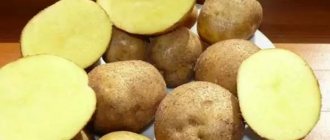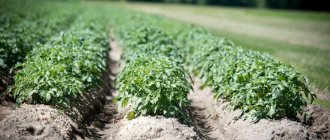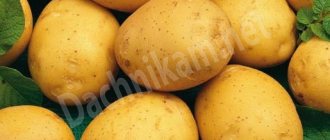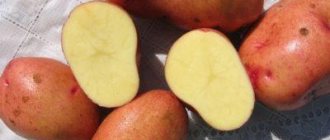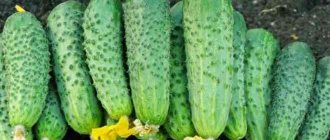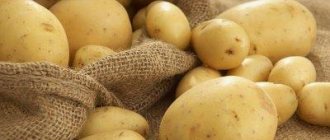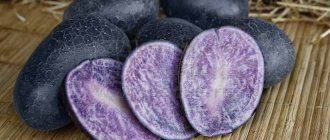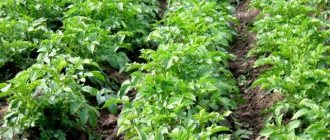The history of the origin of the potato variety "Borovichok"
The variety was bred by folk breeders, but is not included in the state register.
"Borovichok" is well suited for cultivation in warm climates.
In the southern regions of the country (Kuban, Krasnodar Territory, Crimea) 2-3 crops are harvested per year.
The table presents data on the mass of marketable tubers (grams) of different varieties:
| Name | Variety | Weight |
| Nikulinsky | Late ripening | From 70 to 120 |
| Cardinal | Late ripening | 65-110 |
| Rocco | Late ripening | 100-120 |
| Picasso | Late ripening | 80-140 |
| Borovichok | Early ripening | 120-200 |
| Elmundo | Early ripening | 120 |
| Felox | Early ripening | From 100 to 120 |
| Bellarosa | Early ripening | From 120 to 210 |
| Karatop | Extra early | From 58 to 100 |
| Zhukovsky early | Extra early | 100 to 120 |
| Farmer | Extra early | From 90 to 110 |
| Minerva | Extra early | From 120 to 245 |
| Sorcerer | Mid-late | From 75 to 120 |
| Mozart | Mid-late | From 100 to 150 |
| Grenada | Mid-late | From 800 to 100 |
| Melody | Mid-late | From 95 to 180 |
| Giant | Mid-early | 100-140 |
| Tuscany | Mid-early | From 90 to 125 |
| Purple Haze | Mid-early | From 90 to 160 |
| Openwork | Mid-early | 90-120 |
Advantages and disadvantages
Pros:
- ease of care;
- great taste;
- the ability to cook in different ways;
- ability to bear fruit on unsuitable soils;
- resistance to a number of diseases;
- good keeping quality during long-term storage;
- high productivity;
- the variety is not prone to degeneration, and can be grown for a long time from its own harvest.
Minuses:
- the skin is too thin and often suffers during transportation and mechanized collection, which reduces commercial quality.
Description of the variety
“Borovichok” is an early ripening variety. Technical maturity occurs 70 days after emergence, full maturity - after 90 days. The average yield is 200-250 centners per hectare of land.
Bushes
The stem is semi-erect, medium leafy. The bush grows up to 50-60 cm and looks compact. The leaves are small, dark green in color, with a slightly wavy edge. The corollas are large, bloom quickly, without setting berries. The root system is medium branched. Up to 10 root crops are formed under each bush.
Tubers
Potatoes are regular oval in shape and small in size. The average weight of one root vegetable is 120-200 grams. The peel is deep yellow, the flesh is creamy. A characteristic feature of “Borovichka” is its smooth and proportionate root crops without signs of lumpyness. The eyes are superficial.
Characteristics of the Jubilee potato
Jubilee is a potato variety that appeared in the West Siberian region of the Russian Federation. Potatoes are classified as mid-early ripening, as the crop matures in 65 to 80 days. As a rule, the Jubilee harvest is harvested 2 times a year. The first potatoes are dug up 45 days after the Jubilee is planted in the ground. More than 10 fruits can form under one bush.
The potato skin is quite thick, so the root crop is well stored in winter. The Jubilee tubers reach medium or medium-large sizes.
The plant has the following characteristics:
- There is no significant growth of tops;
- Characteristics of the Jubilee bush: straight, tall and stemmed;
- Characteristics of the corollas: they reach large sizes and have a blue tint;
- Characteristics of the leaves of the Jubilee bush: elongated, large and fibrous;
- The potato root system is well developed.
If we talk about the root crop of the variety, it is given the following characteristics:
- Fruit characteristics: reaches 200 g;
- The potato skin is red and the flesh is yellow;
- The eyes of the root vegetable reach medium sizes and have a pink tint;
- Characteristics of tubers: they also reach large sizes and are round in shape.
It should be noted that the root vegetable of the variety is rich in vitamin C and carotenoids. Potatoes are not distinguished by their keeping quality, since it barely reaches 85%. The root vegetable has excellent taste characteristics. At the time of cooking, the fruit pulp does not darken. In addition, the product does not lose vitamins during cooking.
Correct fit
To grow strong and healthy bushes, you must adhere to the generally accepted planting stages, the first of which is plantation planning.
Site selection
The landing site must meet the criteria:
- Illumination. The length of daylight for normal potato growing should be at least 12 hours a day;
- Ventilation. The area must be well ventilated on at least three sides, except the north;
- Lack of groundwater. Closely approaching moisture leads to rotting of the plant roots;
- Correct crop rotation. It is not allowed to plant potatoes in the same place for more than 3 years in a row or in a place where eggplants and tomatoes were planted. Good predecessors for potatoes are cucumbers, carrots, beets, and legumes.
Soil preparation
On depleted soils, the decisive factor for high yields is the application of fertilizers during autumn plowing. The most affordable and high-quality option is rotted manure in an amount of 7-10 kg/sq.m. Winter sowing of green manure crops is also widely practiced: alfalfa, oats, rye.
Seed preparation
For planting, root crops are selected from pre-designated powerful bushes and stored separately from the rest of the crop. At the end of March - beginning of April, preparations are carried out before germination:
- Seeds are sorted, leaving only healthy and dense tubers, without damage or bites;
- A month before planting, germination begins. To do this, take the box with seeds into a well-lit room with a temperature of 10-15 * C;
- Before planting, root crops are treated with growth stimulants "Epin", "Zircon" or soaked in a weak solution of potassium permanganate to destroy surface microbes.
Popular potato varieties:
Planting Density
Recommended planting pattern:
- The interval between bushes is 30 cm;
- Row spacing – 60 cm;
- Planting depth – 10 cm.
Boarding time
“Borovichok” is planted in late April – early May, depending on climatic conditions. It is important that the soil is warmed to 10-12*C. In the central regions, planting in a ridge is recommended, as it better protects young shoots from temperature changes.
"Borovichok" does not require special care. Standard agricultural techniques:
- Watering. In dry weather, water once every 3 days, in cool weather - once every 5-7 days. Watering should be root and deep. It should be done early in the morning or late in the evening. The ideal option is to lay a drip system. This type of irrigation not only ensures gradual and balanced soil moisture, but saves liquid consumption by up to 30%;
- Loosening. The main task of the gardener is to prevent the formation of a hard earthen crust that disrupts air exchange in the soil. Therefore, you need to loosen as the soil dries, especially important after watering;
- Weeding. Weeds compete with potatoes for nutrients, attract pests and become carriers of diseases. Therefore, you need to weed the beds regularly, starting from the appearance of the first shoots;
- Feeding. To reap the maximum harvest, in addition to autumn fertilization, two feedings are recommended during the growing season:
- Diluted droppings during the first weeding;
- Superphosphate and mineral complexes during budding.
Diseases and parasites
The Borovichok variety has characteristics of resistance to common diseases and pests. This variety is almost not affected by late blight due to its early ripeness. Potato cancer and nematode also rarely appear on potatoes of this variety. Sometimes the Colorado potato beetle can invade a plantation.
Potato cancer
This potato disease is caused by a fungus that appears as a result of violations of agricultural practices. The fungus lives in the ground and begins to actively develop at soil temperatures of +16-18 degrees.
Characteristics of disease development can be identified by the appearance of the tubers. Lumps and brown growths form on them. If there is a strong infection with potato cancer, the stems and leaves of the plants also suffer. Over time, the growths grow and the roots begin to rot. Potatoes affected by cancer are unsuitable for consumption.
To prevent the disease, it is recommended to treat the seeds with Fundazol or Maxim. An effective means of prevention would be regular cultivation of the soil by planting green manure on it: mustard, oilseed radish, oats.
Potato cancer cannot be cured, and if it does appear, the plants should be destroyed and quarantine measures should be carried out in the garden. It is necessary to treat the soil with a 2% Nitrafen solution and not plant plants on the site for 2 years.
Nematode
A pest worm that attacks potato bushes and tubers is a nematode. Preventive measures can be carried out using traditional methods:
- When planting potatoes, add onion peels to each hole;
- grow marigolds nearby;
- cultivate the soil by planting green manure.
If the characteristics of a crop disease are detected: sluggish, yellowed leaves on potato bushes, as well as deformations of flowers and shoots, the fight against the nematode should begin. You should not shake discovered pest cysts onto the ground, as they get into the soil and fighting them becomes even more difficult.
Chemical preparations Karbofos and Lindane are used for treatment. Fumigants Chloropicrin and Nemagon also have good characteristics for effective control of nematodes.
Colorado beetle
When there is an invasion of the Colorado potato beetle, which attacks stems and leaves, and sometimes tubers, it is worth taking effective measures. In small areas, beetles are collected by hand and destroyed by dousing them with kerosene. On large plantations, Colorado and Prestige preparations are used.
Reviews about the variety
Gardeners like Borovichok for its ease of cultivation, unpretentiousness to the soil and excellent taste. The yield of the variety is not the highest, but it is stable and does not decrease from year to year. Thanks to the compact root system, digging potatoes is convenient and easy.
Potato Borovichok is an early ripening table variety. From the first shoots to harvesting, it takes from 70 to 90 days. It has good yield; from 1 hectare you can collect more than 200 centners of smooth, beautiful tubers.
Important. Collected root crops are stored well. Despite their thin peel, they are little damaged when digging and can easily withstand manual or mechanical harvesting.
Read all about storing potatoes in winter, in boxes and in the refrigerator, as well as about the terms and conditions for storing peeled root vegetables.
The bushes are medium-sized, compact, erect or semi-erect, with not too spreading branches. The formation of green mass is moderate.
The leaves are medium-sized, dark green, of intermediate type, with slightly wavy edges. The corolla is made up of large white or cream flowers. The flowers quickly fall off and the berries are almost never set.
The root system is well developed; at least 10 large potatoes are formed under the bush. The amount of non-marketable fines decreases when planted in summer, and the spring harvest is more uneven.
In the table below you can see indicators such as yield and number of tubers per bush for other potato varieties:
| Variety name | Productivity (c/ha) | Number of tubers in a bush (pcs) |
| Ilyinsky | 180-350 | 8-13 |
| cornflower | 200-480 | up to 15 |
| Laura | 330-510 | up to 20 |
| Irbitsky | up to 500 | 6-10 |
| Sineglazka | up to 500 | 8-12 |
| Adretta | up to 450 | 15-25 |
| Alvara | 290-440 | 8-14 |
| Breeze | up to 624 | 8-12 |
The variety is little susceptible to diseases: potato canker, various viruses, Alternaria, verticillium, fusarium, golden cyst nematode. It is rarely affected by late blight and scab; in cold rainy weather, root or gray rot may occur.
Plant care is simple. In warm regions, planting begins in March; to protect against cold weather, the beds are covered with film. The next sowing can begin immediately after harvesting the first crop.
In the middle zone, tubers are planted in early May. During the season, plants are hilled 2-3 times; in hot regions, drip watering is recommended. Potatoes can be harvested by machine or by hand.
Yields can be increased by timely application of organic or mineral fertilizers. How and when to apply fertilizers, as well as how to do it correctly when planting, read in separate articles on our website.
Pros and cons of the variety
Borovichok potatoes have a large number of advantages that are incommensurate with the disadvantages. The Borovichok variety has few disadvantages.
pros
- Wonderful taste characteristics.
- High yield.
- Mid-early maturation.
- Possibility of obtaining 2 harvests per season.
- Versatility of use.
- Unpretentiousness to the soil.
- Easy care.
- Resistance to many diseases.
Minuses
Among the minuses, the only characteristics that can be noted are the small size of the root crops and the not very durable skin, which is easily damaged during mechanical digging of potatoes or during transportation.
Features of cultivation
In warm regions, potatoes are planted in early spring; in temperate climates, planting is shifted to early May. Agricultural technology is standard. Before sowing, selected tubers are pickled and soaked in a growth stimulator.
Large tubers, cut into segments with eyes, as well as non-marketable small items are suitable for planting. Under favorable conditions, small potatoes give an excellent harvest, the tubers are even and large.
Potatoes prefer fertile, light soils; they grow poorly on loams. The soil can be enriched with humus, peat and wood ash, laid out in the holes.
Tubers are planted with a depth of 10 cm, the distance between the bushes is from 30 to 35 cm. It is advisable to leave wide row spacing for easy plant care. To protect against weeds, the rows are mulched with mowed grass or straw.
During the season, the bushes bury themselves 2-3 times, forming high ridges. In hot climates, it is useful to organize drip irrigation or water the plants by hand 2-3 times per season, soaking the soil to a depth of 40-50 cm.
Root feeding with potassium sulfate, superphosphate, and diluted mullein is useful. A week before harvesting, it is recommended to cut off all the tops, this will allow the tubers to accumulate maximum nutrients.
We also bring to your attention useful information about which sprays and how they will help when growing potatoes.
As well as materials on the use of herbicides and fungicides, their benefits and harm to plants.
There are many ways to grow potatoes. We offer you useful information about Dutch technologies, about growing under straw, in barrels and bags.
Diseases and pests
The potato variety Borovichok is resistant to many dangerous nightshade diseases.
It is rarely affected by potato cancer, golden cyst nematode, and various viruses.
Early ripening saves tubers and leaves from late blight. To prevent plantings, they are treated with copper-containing preparations.
Dosed watering, frequent hilling and adding wood ash to the soil before planting will help protect plantings from rot.
Fresh potato tops attract a variety of pests: Colorado potato beetles, cicadas, spider mites, and aphids.
Treatment with insecticides will help get rid of insects.
To combat the Colorado potato beetle, we recommend using the following chemicals: Aktara, Corado, Regent, Commander, Prestige, Lightning, Tanrek, Apache, Taboo.
Pre-planting treatment of tubers, as well as correct crop rotation, can prevent the appearance of wireworms.
Every few years, potatoes are planted in new areas, and the vacated areas are sown with phacelia or oilseed radish.
The best predecessors for potatoes are legumes, cabbage, meadow or herbs.
Potato Borovichok is a successful variety, ideal for small farms. Yield and tasty potatoes are suitable for sale or personal consumption; you can collect seed material for planting yourself.
Various classifications of varieties of popular vegetables for every taste
Potatoes are rightly called the second bread, since it is impossible to imagine a culinary dish without this vegetable. Although several centuries ago in Russia they refused to grow this crop or eat it. But the situation changed dramatically after another famine. Since then, potatoes have become an indispensable, favorite product. I will try to give a description of the potato varieties that have taken root best in our country. For convenience, they are divided into different classifications.
Favorite vegetable of many Russians
Colored and exotic
We are accustomed to the fact that most varieties have yellow or pink skin and light flesh. But not so long ago, new varieties of potatoes appeared: colored and exotic. They have an unusual tuber color, which is obtained through natural crossing and not genetic engineering.
Colored and exotic varieties include:
All these types are soft and delicate in taste. But the main advantage is the presence of antioxidants and anthocyanins, which help with infectious diseases. They are also valuable because they maintain the balance of the body, prolonging youth and life.
Colored varieties also include varieties of red potatoes, in which most often only the skin is red:
Watering
"Artemis" tolerates drought, but in dry soil the potato's potential will not be realized. Depending on the weather, crops are watered 3 times a season, and the soil is moistened to a depth of 0.5 meters. The optimal condition for potato growth is the presence of drip irrigation.
We invite you to familiarize yourself with potato varieties that have different ripening periods:
Top dressing
To harvest two crops of Artemis, you need to carry out 2 feedings for each growing season, alternating mineral and organic fertilizers. Spraying with a superphosphate solution a week before harvest gives a good effect.
Potato varieties resistant to bad weather:
